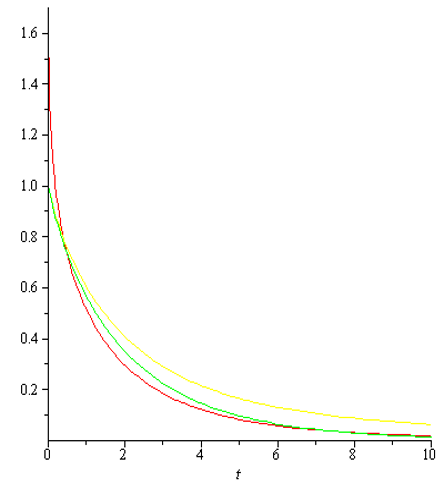On Conformable, Riemann-Liouville, and Caputo fractional derivatives
DOI:
https://doi.org/10.12928/bamme.v2i2.7072Keywords:
Caputo fractional derivative, Conformable fractional derivative, Fractional ordinary differential equations, Riemann-Liouville fractional derivative, SolutionsAbstract
This article compares conformable fractional Derivative with Riemann-Liouville and Caputo fractional derivative by comparing solutions to fractional ordinary differential equations involving the three fractional derivatives via the numerical simulations of the solutions. The result shows that conformable fractional derivative can be used as an alternative to Riemann-Liouville and Caputo fractional derivative for order α with 1/2<α<1.
References
Abdeljawad, T. (2015). On conformable fractional calculus. Journal of computational and Applied Mathematics, 279, 57-66.
Adams, E. E., & Gelhar, L. W. (1992). Field study of dispersion in a heterogeneous aquifer: 2. Spatial moments analysis. Water Resources Research, 28(12), 3293-3307.
Berkowitz, B., Cortis, A., Dentz, M., & Scher, H. (2006). Modeling non‐Fickian transport in geological formations as a continuous time random walk. Reviews of Geophysics, 44(2), 1-49.
Hatano, Y., & Hatano, N. (1998). Dispersive transport of ions in column experiments: An explanation of long‐tailed profiles. Water Resources Research, 34(5), 1027-1033.
Khalil, R., Al Horani, M., Yousef, A., & Sababheh, M. (2014). A new definition of fractional derivative. Journal of computational and applied mathematics, 264, 65-70.
Kilbas, A. A., Srivastava, H. M., Trujilo, J. J. (2006). Theory and Application of Fractional Differential Equations. Elsevier.
Laffaldano, G., Caputo, M., & Martino, S. (2006). Experimental and theoretical memory diffusion of water in sand. Hydrology and Earth System Sciences, 10(1), 93-100.
Podlubny, I. (1999). Fractional Differential Equations. Academic Press.

Downloads
Published
Issue
Section
License
Copyright (c) 2022 Bambang Hendriya Guswanto, Leony Rhesmafiski Andini, Triyani Triyani

This work is licensed under a Creative Commons Attribution-ShareAlike 4.0 International License.
Authors who publish with this journal agree to the following terms:
- Authors retain copyright and grant the journal right of first publication with the work simultaneously licensed under Creative Commons Attribution License that allows others to share the work with an acknowledgement of the work's authorship and initial publication in this journal.
- Authors are able to enter into separate, additional contractual arrangements for the non-exclusive distribution of the journal's published version of the work (e.g., post it to an institutional repository or publish it in a book), with an acknowledgement of its initial publication in this journal.
- Authors are permitted and encouraged to post their work online (e.g., in institutional repositories or on their website) prior to and during the submission process, as it can lead to productive exchanges, as well as earlier and greater citation of published work (See The Effect of Open Access).



